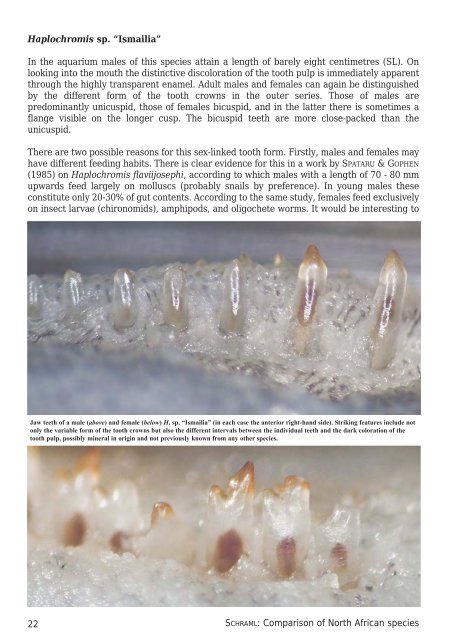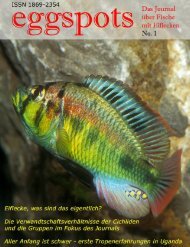Eggspots Elsewhere - Welt der Fische / World of Fishes
Eggspots Elsewhere - Welt der Fische / World of Fishes
Eggspots Elsewhere - Welt der Fische / World of Fishes
Create successful ePaper yourself
Turn your PDF publications into a flip-book with our unique Google optimized e-Paper software.
Haplochromis sp. “Ismailia”<br />
In the aquarium males <strong>of</strong> this species attain a length <strong>of</strong> barely eight centimetres (SL). On<br />
looking into the mouth the distinctive discoloration <strong>of</strong> the tooth pulp is immediately apparent<br />
through the highly transparent enamel. Adult males and females can again be distinguished<br />
by the different form <strong>of</strong> the tooth crowns in the outer series. Those <strong>of</strong> males are<br />
predominantly unicuspid, those <strong>of</strong> females bicuspid, and in the latter there is sometimes a<br />
flange visible on the longer cusp. The bicuspid teeth are more close-packed than the<br />
unicuspid.<br />
There are two possible reasons for this sex-linked tooth form. Firstly, males and females may<br />
have different feeding habits. There is clear evidence for this in a work by SPATARU & GOPHEN<br />
(1985) on Haplochromis flavii josephi, according to which males with a length <strong>of</strong> 70 - 80 mm<br />
upwards feed largely on molluscs (probably snails by preference). In young males these<br />
constitute only 20-30% <strong>of</strong> gut contents. According to the same study, females feed exclusively<br />
on insect larvae (chironomids), amphipods, and oligochete worms. It would be interesting to<br />
Jaw teeth <strong>of</strong> a male (above) and female (below) H. sp. “Ismailia” (in each case the anterior right-hand side). Striking features include not<br />
only the variable form <strong>of</strong> the tooth crowns but also the different intervals between the individual teeth and the dark coloration <strong>of</strong> the<br />
tooth pulp, possibly mineral in origin and not previously known from any other species.<br />
22<br />
SCHRAML: Comparison <strong>of</strong> North African species




